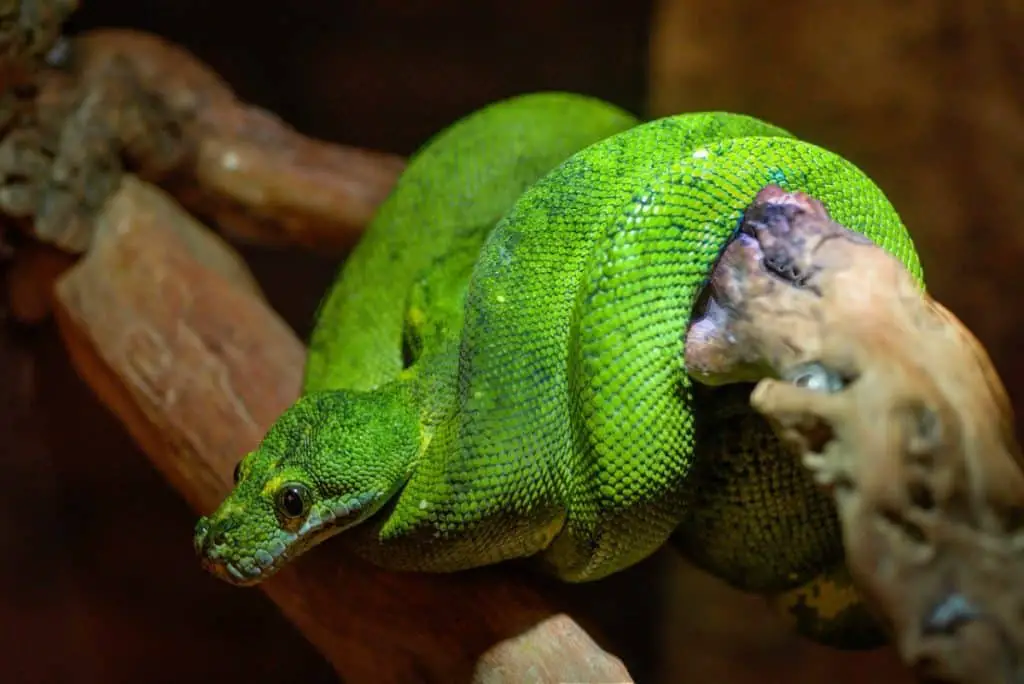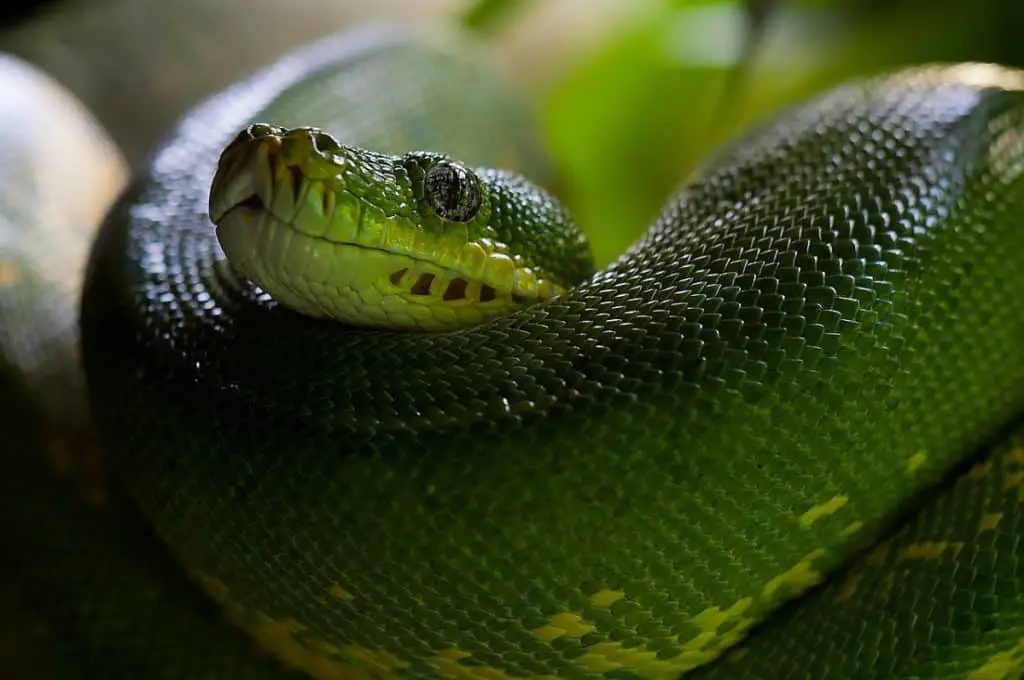With more snakes seemingly being found every day, scientists have divided almost 4,000 species into various families.
There are eighteen families of snakes. File snakes, coral pipe snakes, dwarf pipe snakes, mole vipers, boas, round island boas, colubrids, Asian pipe snakes, Cobras and related, Mexican burrowing snakes, pythons, dwarf boas, short-tailed snakes, vipers, and sunbeam snakes make up one infraorder. Dawn blind snakes, slender blind snakes, and blind snakes make up the second infraorder.
The snakes in each of the families have features in common. Let’s look at these individually.
If you want to know how snakes eat their prey, I have written an article here.

Colubrids (Colubridae)
The largest family is the colubrid family, with nearly 2,000 species. Almost three-quarters of the world’s snakes belong to this family. Snakes in this family have no left lung or hip bones, and most are not poisonous.
Colubrid snakes include brown tree snakes, boomslang, common garter snakes, and corn snakes.
File snakes (Acrochordidae)
This family includes the elephant trunk snake, little wart snake, and the Arafura file snake. Members of this family are aquatic snakes living in freshwater. They have loose skin, and their scales do not overlap, giving them a file-like appearance.
Do you know why snakes have different colours? Find out in this article I wrote
Coral pipe snakes (Aniliidae)
Containing only one species and two subspecies, the false coral snake is also known as the American pipe snake. This can be found in South America and is distinct from other families due to its vestigial pelvic girdle, which can be seen as pair of cloacal spurs.
Dwarf pipe snakes (Anomochilidae)
This family has three species found in Malaysia, Borneo, and Indonesia. The difference from other families is that they lack a chin groove and have no teeth on their pterygoid bone.
Did you know there are three ways that snakes kill their prey? Find out what they are here.
Mole vipers (Atractaspididae)
This family contains 58 species found in Africa and the Middle East. It is one of the most ambiguous families, with many species being moved in and out.
Harlequin snakes, two-headed snakes, quill-snouted snakes, and the African bighead snake are all part of this family.
Boas (Boidae)
Boas are one of the best-known families of snakes containing nearly 50 species. They have elongated skulls and share characteristics with pythons. However, they lack a bone behind the orbit of the eye and have hind limbs that are visible as a pair of spurs.
This family includes some of the largest snakes worldwide, including the green anaconda and the emerald tree boa.
Round Island boas (Bolyeridae)
There are only species of Round Island ground boa found on Round Island near Mauritius. They are nonvenomous and have a split jaw that allows them to feed on geckos and skinks. They change colour during the day from dark to light brown.
Asian pipe snakes (Cylindrophiidae)
Thirteen species of Asian pipe snakes can be found in Indonesia, Myanmar, Malaysia, Vietnam, Thailand, Sri Lanka, Borneo, and China. They are burrowing snakes with five characteristics different from other families. They have a blunt head with small eyes, well-developed ventral scales, a pair of pelvic spurs, short tails, and ventral blotching.
Species include the Island pipe snake, Slowinski’s pipe snake, and Yamdena pipe snake.
Did you know that snakes don’t stop growing? Find out more here
Cobras, coral snakes, mambas, kraits, sea snakes, sea kraits, Australian elapids (Elapidae)
An extensive and diverse family with almost 300 species, elapids include some of the most venomous snakes in the world. They have non-moving fangs at the front of their mouth to inject neurotoxins and hemotoxins. They can be found in many areas, including South Africa, Australia, Indonesia, India, Afghanistan, and Papua New Guinea and can be terrestrial or semiaquatic.
Species include king cobras, sea kraits, tiger snakes, coral snakes, and taipans.
Mexican burrowing snakes (Loxocemidae)
Containing only one species, the Mexican burrowing python. They can be found in Mexico, Guatemala, Honduras, El Salvador, Nicaragua, and Costa Rica.
They have an upturned snout with large scales on the head. They have pelvic spurs and are rarely seen as they burrow in loose soil.
Did you know there are six butterfly families? Find out what they are and how to identify them.

Pythons (Pythonidae)
Pythons are one of the best-known families on this list. They are some of the largest, nonvenomous snakes in the world. There are 42 species of pythons worldwide and can be found in Africa, Nepal, China, Australia, Pakistan, Philippines, Bangladesh, Papua New Guinea and much of Southeast Asia. There is also a species in the United States.
Reticulated pythons are the longest snake globally, with the longest measuring 10 metres. Pythons live in many different habitats, including some excellent climbers and others that can swim.
Dwarf boas (Tropidophiidae)
Also known as thunder snakes, this family contains 19 species. They can be found from Mexico down to South America, the West Indies, and the Caribbean. As their name suggests, dwarf boas are small snakes measuring up to 60cm (24in) long.
Species are generally named after the island they live, with the Haitian dwarf boa and the Cayman Islands dwarf boa being examples, although the black-bellied dwarf boar and the leopard dwarf boa are named after their markings.
Short-tailed snakes (Uropeltidae)
Short-tailed or shield-tailed snakes are nonvenomous snakes found in India and Sri Lanka. They have a keratine shield at the tip of their tail, much like rattlesnakes. They are fossorial, burrowing into the ground, and when sensing predators, they will coil their bodies, hiding their heads.
Short-tailed snaked eggs hatch within the mother’s body, and there are thought to be over 50 species.
Vipers, pitvipers, rattlesnakes (Viperidae)
Members of the viper family are venomous snakes. Vipers are characterised by their long, hinged fangs that allow their venom to be injected. The fangs fold back when not in use and can be moved independently. Because they can be moved back, the fangs are incredibly long as their mouths open nearly 180 degrees.
Pit vipers have sensory organs called heat-sensing pits that allow them to detect thermal radiation from their prey. There are over 200 species of viper, and it can be found in many countries worldwide. Some of the most well-known species include rattlesnakes, Moccasins, and pit vipers.
Sunbeam snakes (Xenopeltidae)
There are two species of sunbeam snakes in this family. They are burrowing snakes that can be found in Southeast Asia and China. Unlike most other snakes, they have two working lungs. Their name comes from their iridescent scales.
Dawn blind snakes (Anomalepidae)
Dawn blind snakes are nonvenomous found in Central and South America. They are members of the Scolecophidia infraorder. They are small snakes measuring 30cm (12in) long. They are fossorial, burrowing into the ground and feeding on ant and termite eggs and larvae. Although they have eyes, these are vestigial. The eyes reduce as the foetus grows, leaving them blind when born.
Slender blind snakes (Leptotyphlopidae)
Slender blind snakes are a member of the Scolecophidia infraorder. They are fossorial and feed on the eggs and larvae of ants and termites. They don’t have teeth and have a blunt head that allows them to travel underground. This family includes the Barbados thread snake, the world’s smallest snake, measuring just under 25mm (1in.)
Blind snakes (Typhlopidae)
Blind snakes in this family live in burrows with vestigial eyes. However, they can detect light through black eyespots. There are over 200 species, and they are found in Africa, Asia, Pacific Islands, Central and South America, and parts of Europe.
Some species are tiny, measuring just 5cm (2in) long, making them one of the smallest snakes in the world.
